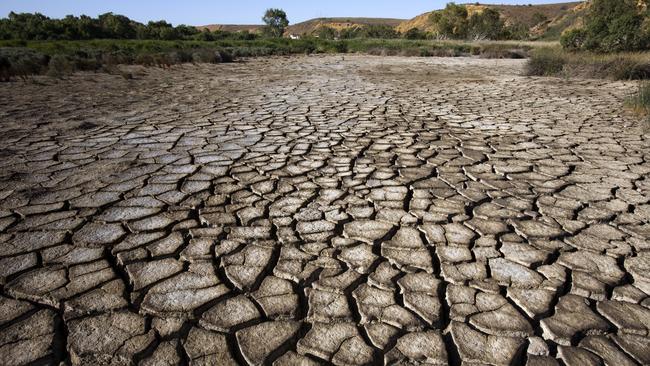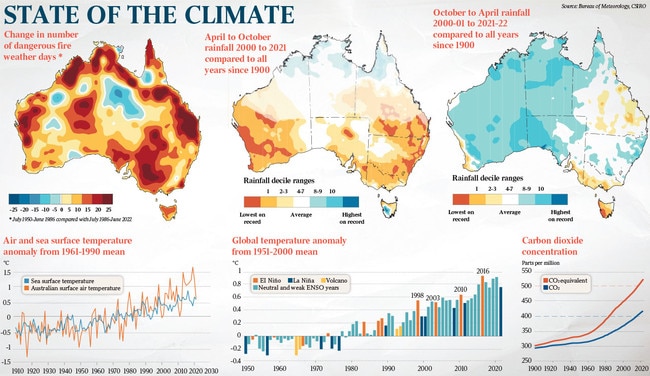Future shock: more heat, more bushfires, more droughts, say BoM and CSIRO
Australians are facing a future of hotter summers, longer bushfire seasons, less rain and more droughts.

The global decline in fossil fuel consumption during the Covid-19 pandemic will have a “negligible” impact on climate change, with Australians facing a future of hotter summers, longer bushfire seasons, less rain and more droughts.
A report released by the Bureau of Meteorology and CSIRO showed Australia’s climate has warmed by 1.47C since 1910, with sea temperatures increasing by 1.05C.
“The decline in global fossil fuel emissions of CO2 in 2020 associated with the Covid-19 pandemic will have a negligible impact on climate change,” the report says.
“Atmospheric CO2 concentrations continue to rise, and fossil fuel CO2 emissions, the principal driver of this growth, were back to near pre-pandemic levels in 2021.”
Under the Paris Agreement, governments are trying to keep global warming to 1.5C of pre-industrial levels, with average global air temperature increasing by about 1C since 1850.
With Australia already nearly at the 1.5C benchmark, the State of the Climate report warns there will be “continued increase in air temperatures, more heat extremes and fewer cold extremes”.
“(There will be) continued decrease, on average, in cool season rainfall across many regions of southern and eastern Australia, which will likely lead to more time in drought, but with ongoing climate variability that will give rise to short-duration heavy-rainfall events at a range of timescales,” the report said. “Continued increase in the number of dangerous fire weather days and a longer fire season for southern and eastern Australia (is predicted).”
The report said most warming in Australia had occurred since 1950.
“Every decade since 1950 has been warmer than preceding decades. Australia’s warmest year on record was 2019. The eight years from 2013 to 2020 all rank among the 10 warmest years on record.

“The long-term warming trend means that most years are now warmer than almost any observed during the 20th century.”
The report showed there had been a 19 per cent decline in rainfall between May and July in southwestern Australia since the 1970s, while southeastern Australia had registered a 10 per cent decline in rainfall from April to October since the late 1990s.
“There has been an increase in extreme fire weather, and a longer fire season, across large parts of the country since the 1950s,” the report said.
“Sea levels are rising around Australia, including more frequent extremes that are increasing the risk of inundation and damage to coastal infrastructure and communities.”
Environment Minister Tanya Plibersek said the State of the Climate report was “sobering reading”.
Science Minister Ed Husic said the government was “elected with a mandate to tackle the challenges posed by climate change after a decade of denial and delay”.
“We are acting across government to bring down emissions while creating jobs and economic opportunity,” Mr Husic said.




To join the conversation, please log in. Don't have an account? Register
Join the conversation, you are commenting as Logout